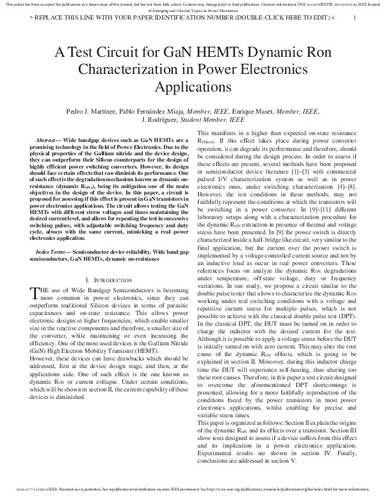A Test Circuit for GaN HEMTs Dynamic Ron Characterization in Power Electronics Applications
Autor(es) y otros:
Palabra(s) clave:
HEMTs
Semiconductor device reliability
Fecha de publicación:
Editorial:
IEEE
Versión del editor:
Resumen:
Wide bandgap devices such as GaN HEMTs are a promising technology in the field of Power Electronics. Due to the physical properties of the Gallium nitride and the device design, they can outperform their Silicon counterparts for the design of highly efficient power switching converters. However, its design should face certain effects that can diminish its performance. One of such effect is the degradation mechanism known as dynamic onresistance (dynamic RON,), being its mitigation one of the main objectives in the design of the device. In this paper, a circuit is proposed for assessing if this effect is present in GaN transistors in power electronics applications. The circuit allows testing the GaN HEMTs with different stress voltages and times maintaining the desired current level, and allows for repeating the test in successive switching pulses, with adjustable switching frequency and duty cycle, always with the same current, mimicking a real power electronics application
Wide bandgap devices such as GaN HEMTs are a promising technology in the field of Power Electronics. Due to the physical properties of the Gallium nitride and the device design, they can outperform their Silicon counterparts for the design of highly efficient power switching converters. However, its design should face certain effects that can diminish its performance. One of such effect is the degradation mechanism known as dynamic onresistance (dynamic RON,), being its mitigation one of the main objectives in the design of the device. In this paper, a circuit is proposed for assessing if this effect is present in GaN transistors in power electronics applications. The circuit allows testing the GaN HEMTs with different stress voltages and times maintaining the desired current level, and allows for repeating the test in successive switching pulses, with adjustable switching frequency and duty cycle, always with the same current, mimicking a real power electronics application
Patrocinado por:
This work was supported in part by the Spanish Government under the Project MINECO-FEDER ESP2015-68117-C2-1-R,in part by the scholarship CEICE-GVA-ACIF-2016-330
Colecciones
Ficheros en el ítem




